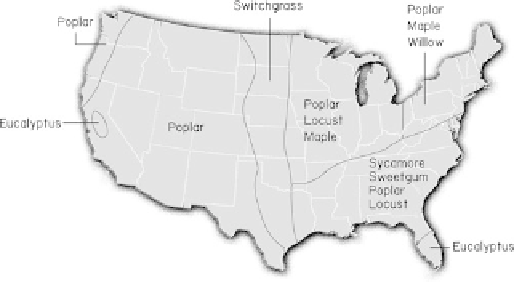Environmental Engineering Reference
In-Depth Information
7.1.1 Herbaceous Plants
7.1
Plant Types and Selection Criteria
Herbaceous plants do not have woody material in their
structure. Herbaceous plants grow from meristematic tissue
in a primary pattern, with no secondary growth. In fact, the
derivation of herbaceous is
herb
, which is Latin for grass.
Examples of herbaceous plants are given here in order of
their relation to the depth to groundwater. This relation
between plant type and depth to water table was given
the term phreatophytic facies in Chap. 1. Most herbaceous
plants typically use sources of water other than groundwater.
In some cases, the depth to water table in areas of herbaceous
growth may be greater than 4-8 ft (1.2-2.4 m); however, in
areas that have a higher percentage of clays, soil moisture
generally extends from the capillary fringe to land surface.
Perhaps the best known herbaceous plant that also is a
phreatophyte and has the potential, therefore, to be used for
phytoremediation to control groundwater is alfalfa
(
Medicago sativa
) (Table
7.1
). As we saw in Chap. 1, O.E.
Meinzer used alfalfa to report what is probably the first
published interaction between plants and groundwater.
Alfalfa was probably imported to the United States through
Georgia in the early 1700s (Meinzer 1927) and can be found
today abundantly in every state in the United States. The
roots of alfalfa can exceed lengths of 60 ft (18 m) if the depth
to water table is that deep, especially in upland areas. Per-
haps the most notable evidence that alfalfa is a phreatophyte
is that it can grow, but perhaps not thrive, as a cultivated
plant with no irrigation. Transpiration rates between 1.7 and
10.5 mm/day have been reported (Interstate Technology
Regulatory Council 2009).
In low-lying areas that are consistently wet, intermittently
wet, or submerged at least part of the year is where the
herbaceous cattails, rushes, and sedges, of the genera
Typha, Juncus,
and
Scirpus,
respectively, grow. During
The establishment of biomass is a fundamental criterion for
success at phytoremediation sites. It is reasonable, therefore,
to investigate the factors related to plant establishment and
to discuss the parameters that limit potential growth and how
to take the appropriate measures to ensure growth over the
life of the project. These issues must be addressed during the
design stage of a phytoremediation project in conjunction
with or following the site-assessment and characterization
activities discussed in Chap. 6.
Based on the knowledge of plant and groundwater
interactions presented in Part I, a few well-known herba-
ceous and woody plants that use groundwater are candidates
for use at phytoremediation sites where hydrologic control is
a goal. Examples of plants of each type are alfalfa and hybrid
poplars, respectively. Many phreatophytes can have a large
range of distribution but may not thrive in all climates where
needed. Conversely, some plants are restricted to one type of
hydroecology and can be used only when specific conditions
are available or engineered.
A map was developed by the Department of Energy
(DOE) biomass program that depicts the types of relatively
fast-growing species that do well in certain areas of the
country (Fig.
7.1
). This map also is applicable to predict
areas where the installation of a phytoremediation project
may be warranted. Alternative plants also may be considered
but will be discussed in less detail because less is known
about their success at phytoremediation sites. Moreover, the
lists of various herbaceous and woody plants presented here
are to suggest which native or indigenous plants at a site can
be used to either assess the presence of groundwater or to act
as part of an overall hydrologic-control system.
Table 7.1
Representative herbaceous phreatophytes native to the
western United States (Modified from Robinson 1958) that may have
phytoremediation potential to influence groundwater.
Common
name
Scientific
name
Relation to groundwater
Depth to water
table below
land, ft (m)
Remarks
Bermuda
grass
Cynodon
dactylon
na
Subtropical plant, from
India.
Alfalfa
Medicago
sativa
4 (1.2)
Sacaton
Sporobolus
airoides
5-25
Deep root system.
Vanadium
bush
Cowania
stansburiana
(1.5-7.6)
Indicates vanadium-
uranium deposits and can
absorb uranium.
Fig. 7.1
Identified plant species that do well in certain parts of the
United States for fiber production. These plants also have the potential
to interact with groundwater because they are fast growing and have
deep root systems.
Saltgrass
Distichlis
spp.
2-12 (0.6-3.60) Grows near ocean or in
desert.
na
not applicable










Search WWH ::

Custom Search